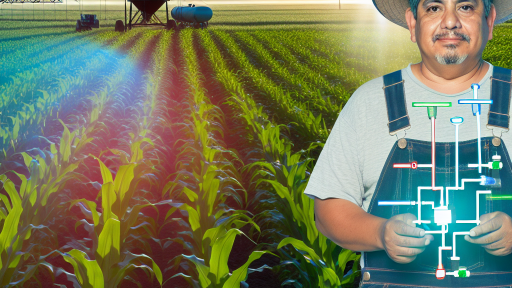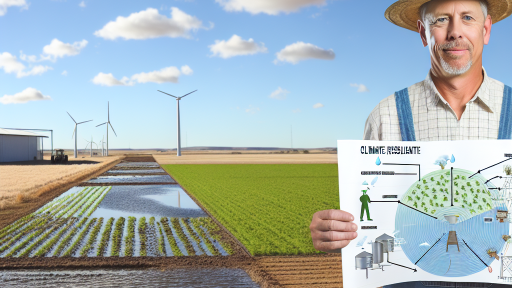Understanding Carbon Footprint
Definition of Carbon Footprint
A carbon footprint measures the total greenhouse gas emissions.
It includes emissions from various activities and processes.
In agriculture, this footprint stems from various sources.
These sources may include fuel use, fertilizer application, and livestock maintenance.
Importance in Agriculture
Reducing the carbon footprint is vital for sustainable farming.
Farmers must consider their impact on climate change.
Every farming practice contributes to emissions levels.
Lowering emissions can enhance soil health and biodiversity.
Benefits of Carbon Footprint Reduction
Reducing the carbon footprint can lead to financial savings.
For instance, minimizing fuel use lowers operational costs.
Additionally, it opens new market opportunities for farmers.
Consumers increasingly seek sustainably produced goods.
Strategies for Farmers
Farmers can adopt various methods to decrease their carbon footprint.
Implementing no-till farming preserves soil integrity.
Diverse crop rotations can improve soil fertility and reduce pests.
Transform Your Agribusiness
Unlock your farm's potential with expert advice tailored to your needs. Get actionable steps that drive real results.
Get StartedUtilizing renewable energy sources can also help lower emissions.
Finally, adopting efficient livestock management practices is beneficial.
Soil Health Management: Strategies to Enhance Soil Carbon Sequestration
Importance of Soil Carbon Sequestration
Soil carbon sequestration plays a critical role in climate change mitigation.
It helps reduce atmospheric carbon dioxide levels.
Additionally, improved soil health boosts agricultural productivity.
Farmers can benefit financially through sustainable practices.
Implementing Cover Crops
Cover crops are an effective way to enhance soil carbon storage.
They prevent soil erosion and enhance nutrient cycling.
Farmers such as Emily Granger have reported improved soil fertility.
Winter rye and clover are popular cover crop options.
Benefits of Cover Crops
- Increases organic matter in soil.
- Improves soil structure and water retention.
- Reduces weed pressure and pest populations.
Adopting Conservation Tillage Practices
Conservation tillage minimizes soil disturbance and increases carbon retention.
This method maintains soil structure and promotes biodiversity.
Farmers like Jacob Henson have witnessed remarkable results from conservation tillage.
It also reduces fuel costs and labor requirements.
Key Conservation Tillage Techniques
- No-till farming.
- Strip tillage.
- Reduced tillage methods.
Utilizing Organic Amendments
Organic amendments increase soil carbon levels significantly.
Compost, manure, and biochar are excellent choices for farmers.
For example, the Johnson family sees significant yields from using compost.
These amendments enhance microbial activity and improve soil structure.
Advantages of Organic Amendments
- Enhanced soil fertility and nutrient availability.
- Improved water retention capabilities.
- Reduction in chemical fertilizer usage.
Integrating Agroforestry Practices
Agroforestry combines agriculture and forestry for better carbon management.
This practice enhances biodiversity and optimizes land use.
Farmers like Maria Thompson have successfully integrated tree planting.
It provides additional income from timber and non-timber products.
Agroforestry Techniques
- Alley cropping.
- Silvopasture.
- Forest farming.
Monitoring and Assessment
Regularly monitoring soil health is crucial for successful carbon sequestration.
Farmers should conduct soil tests to assess organic matter levels.
Showcase Your Farming Business
Publish your professional farming services profile on our blog for a one-time fee of $200 and reach a dedicated audience of farmers and agribusiness owners.
Publish Your ProfileTherefore, tracking progress helps in making informed management decisions.
Farm advisors can also provide valuable insights and support.
Adopting Conservation Tillage Practices
What is Conservation Tillage?
Conservation tillage involves minimal soil disturbance during planting.
It maintains soil structure and organic matter effectively.
This practice retains moisture and reduces erosion.
Farmers often use it to enhance soil fertility.
Methods of Conservation Tillage
Several techniques exist under the conservation tillage umbrella.
No-till farming eliminates plowing altogether.
Minimum tillage reduces the frequency and intensity of tillage.
Strip tillage cultivates only a narrow strip for planting.
These methods significantly lower carbon emissions.
Benefits for Farmers
Farmers gain numerous advantages from adopting these practices.
Firstly, conservation tillage improves soil health.
This method enhances the soil’s ability to hold water.
Consequently, crops receive the moisture they need.
Additionally, farmers can save on fuel costs.
Fuel savings arise from reduced tillage operations.
Furthermore, the increased organic matter boosts crop yields.
Implementing Conservation Tillage
To implement conservation tillage, farmers should start small.
Testing various methods on a smaller scale is advisable.
Monitoring results helps determine the best practices.
Farmers can also seek guidance from local agricultural experts.
Joining farming cooperatives can provide support and resources.
Challenges to Consider
Despite the benefits, challenges may arise.
Some farmers may struggle with initial implementation.
There can be a learning curve when adopting new techniques.
Additionally, certain crops may require specific tillage practices.
Identifying compatible crops is vital for success.
Discover More: Advanced Mulching Techniques to Preserve Soil Moisture
Crop Rotation and Diversity: Reducing Soil Erosion and Carbon Emissions
Benefits of Crop Rotation
Crop rotation enhances soil health significantly.
It helps break pest and disease cycles.
This practice also reduces soil erosion effectively.
Additionally, it improves nutrient availability in the soil.
Implementing Crop Diversity
Diverse crops contribute to a resilient agricultural system.
They attract beneficial insects for pollination.
Moreover, they can suppress weeds naturally.
Cultivating different crops minimizes the risk of total crop failure.
Practical Steps for Farmers
Farmers can start by planning their crop rotations yearly.
They should include legumes to enhance nitrogen levels.
Monitoring soil conditions is crucial for effective implementation.
Showcase Your Farming Business
Publish your professional farming services profile on our blog for a one-time fee of $200 and reach a dedicated audience of farmers and agribusiness owners.
Publish Your ProfileMoreover, using cover crops before main planting helps maintain soil structure.
Innovative Practices to Explore
Integrating agroforestry can enhance both carbon sequestration and biodiversity.
Using organic amendments improves soil texture and nutrient content.
Implementing no-till farming reduces soil disturbance.
Lastly, precision agriculture technologies can optimize land use.
Measuring Success
Farmers should track changes in yield and soil health over time.
Evaluating carbon footprint reduction will provide valuable insights.
Regular assessments help in refining practices for better outcomes.
Gain More Insights: Implementing Cover Crops to Enhance Water Retention
Integrating Livestock with Crop Production
Understanding the Synergy Between Livestock and Crops
Integrating livestock with crop production enhances sustainability.
This practice maximizes resource use while minimizing waste.
Livestock provide natural fertilizer through manure.
In turn, crops benefit from enhanced nutrient availability.
Additionally, livestock can help control pests in crop fields.
Benefits of Mixed Farming Systems
Mixed farming systems can boost farm profitability.
They diversify income sources for farmers.
By incorporating livestock, farmers can reduce the need for chemical fertilizers.
This approach also supports healthier soil management practices.
Consequently, it enhances resilience to climate change impacts.
Implementing Sustainable Practices
Farmers can adopt rotational grazing methods for efficient resource use.
This method prevents overgrazing and soil degradation.
Moreover, cover crops can improve soil health and structure.
Integrating crop residues into livestock diets further reduces waste.
Using agroforestry practices can enhance biodiversity on the farm.
Enhancing Soil Health
Soil health is crucial in sustaining productive agriculture.
Livestock manure adds organic matter to the soil.
This organic material improves soil structure and moisture retention.
Healthy soil supports diverse microbial communities that aid plant growth.
Reducing Carbon Emissions
Integrating livestock and crop production contributes to carbon footprint reduction.
Diverse agricultural systems can sequester more carbon in the soil.
This continued effort mitigates the effects of climate change.
Farmers can implement practices to monitor carbon levels effectively.
See Related Content: Benefits of Renewable Energy for Modern Farmers

Utilizing Renewable Energy on Farms
Embracing Solar Energy
Solar energy is a powerful resource for farms.
It provides a renewable source of electricity.
Farmers can install solar panels on rooftops or land.
This setup reduces dependency on fossil fuels.
Additionally, it lowers energy bills significantly.
For instance, Green Fields Farm switched to solar power.
They now save over 30% on their energy costs annually.
Showcase Your Farming Business
Publish your professional farming services profile on our blog for a one-time fee of $200 and reach a dedicated audience of farmers and agribusiness owners.
Publish Your ProfileFarmers can also take advantage of state incentives.
These incentives can help cover installation expenses.
Harnessing Wind Energy
Wind energy offers another sustainable option for farmers.
Wind turbines can generate significant amounts of electricity.
Farmers with large open spaces can benefit the most.
Like Sunridge Dairy, they installed wind turbines last year.
This installation has provided them with enough energy to operate.
Moreover, they sell excess energy back to the grid.
Wind energy reduces both carbon footprint and costs.
Farmers should assess local wind patterns and regulations.
Effective planning ensures better energy yield.
Utilizing Biomass Resources
Biomass energy is derived from organic materials.
Farmers can use agricultural waste to generate power.
For example, composting farm waste enhances soil health.
Moreover, it can produce biogas for various applications.
Riverview Farms utilizes manure to power their operations.
This approach drastically reduces their waste disposal costs.
Additionally, biomass can help in heating farm buildings.
Farmers can convert their surplus crops into biofuels.
These practices not only minimize waste but also save money.
Seamless Integration of Renewable Options
Integrating multiple renewable sources can maximize efficiency.
Many farms find success by combining solar and wind energies.
This strategy creates a more reliable power source.
Furthermore, it diversifies energy management systems.
Farmers should consider local conditions while planning.
Each region’s climate plays a crucial role in energy choices.
With thoughtful implementation, farmers can thrive sustainably.
Delve into the Subject: Climate Risks And Crop Yield Declines
Implementing Precision Agriculture: Technology for Efficient Resource Use
Understanding Precision Agriculture
Precision agriculture involves using technology to enhance farming practices.
This approach allows farmers to optimize their resources effectively.
It leverages data analytics and advanced equipment.
With precision agriculture, farmers can make informed decisions based on real-time data.
The Role of Technology
Technology plays a critical role in implementing precision agriculture.
Tools such as GPS and drones aid in mapping and surveying fields.
These technologies provide detailed insights into soil conditions and crop health.
Additionally, sensors can monitor moisture levels and nutrient availability.
Data Collection and Analysis
Data collection is essential for effective precision agriculture.
Farmers can use satellite imagery to assess crop health across vast areas.
Moreover, data analysis helps in pinpointing specific areas that need attention.
This targeted approach minimizes waste and enhances productivity.
Showcase Your Farming Business
Publish your professional farming services profile on our blog for a one-time fee of $200 and reach a dedicated audience of farmers and agribusiness owners.
Publish Your ProfileImplementing Variable Rate Technology
Variable rate technology (VRT) allows precise application of inputs.
This includes fertilizers, pesticides, and water, tailored to specific field areas.
By using VRT, farmers reduce excess usage of resources.
Consequently, they lower costs and minimize their carbon footprint.
Benefits of Precision Agriculture
Precision agriculture brings several advantages to farmers.
First, it enhances crop yield while reducing resource consumption.
Next, it allows for better management of environmental impacts.
Finally, increased efficiency leads to improved farm profitability.
Sustainability in Farming
Sustainability is a key goal of precision agriculture.
This method supports sustainable practices by conserving resources.
Farmers can maintain soil health and protect water resources more effectively.
Ultimately, this promotes long-term agricultural viability.
The Role of Agroforestry: Trees as Carbon Sinks in Farming Systems
Introduction to Agroforestry
Agroforestry integrates trees into farming landscapes.
This practice enhances biodiversity while promoting agricultural sustainability.
Farmers benefit by creating diverse ecosystems on their land.
Carbon Sequestration Potential
Trees act as effective carbon sinks in agricultural systems.
They absorb carbon dioxide from the atmosphere through photosynthesis.
Furthermore, trees store carbon in their biomass and soil.
As a result, agroforestry plays a crucial role in mitigating climate change.
Benefits of Trees in Farming
Trees provide multiple benefits to farming systems.
- They improve soil health by preventing erosion.
- Trees enhance water retention in the soil.
- They offer habitat for various wildlife species.
- Additionally, they contribute to pollinator health.
Implementing Agroforestry Practices
Farmers can implement several agroforestry practices on their land.
Mixed-species planting is a popular method.
Another practice involves intercropping trees with crops.
This method maximizes space and increases yields.
Moreover, alley cropping combines agricultural crops with tree rows.
Choosing Suitable Tree Species
Selecting the right tree species is essential for success.
Farmers should consider local climate and soil conditions.
For example, nitrogen-fixing trees improve soil fertility.
Additionally, native species are often the best choice for biodiversity.
Long-Term Impact on Farm Sustainability
Agroforestry enhances long-term sustainability in farming.
By improving ecosystem services, farmers can secure their livelihoods.
Moreover, increased carbon sequestration benefits the environment.
This practice creates a win-win situation for farmers and the planet.
Additional Resources
Environmental Impacts of Food Production – Our World in Data




